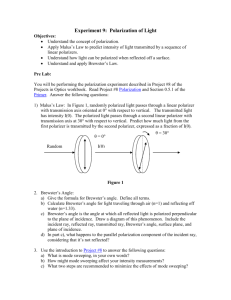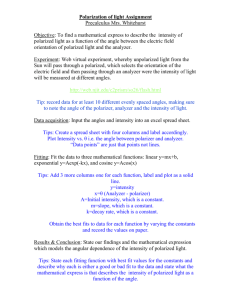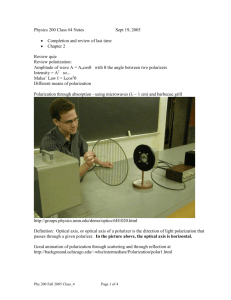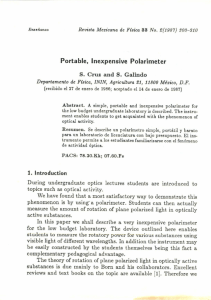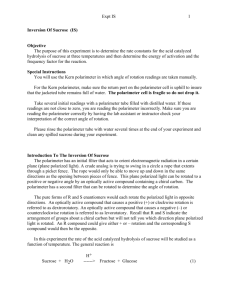O11e „Polarisation and Optical Activity“
advertisement
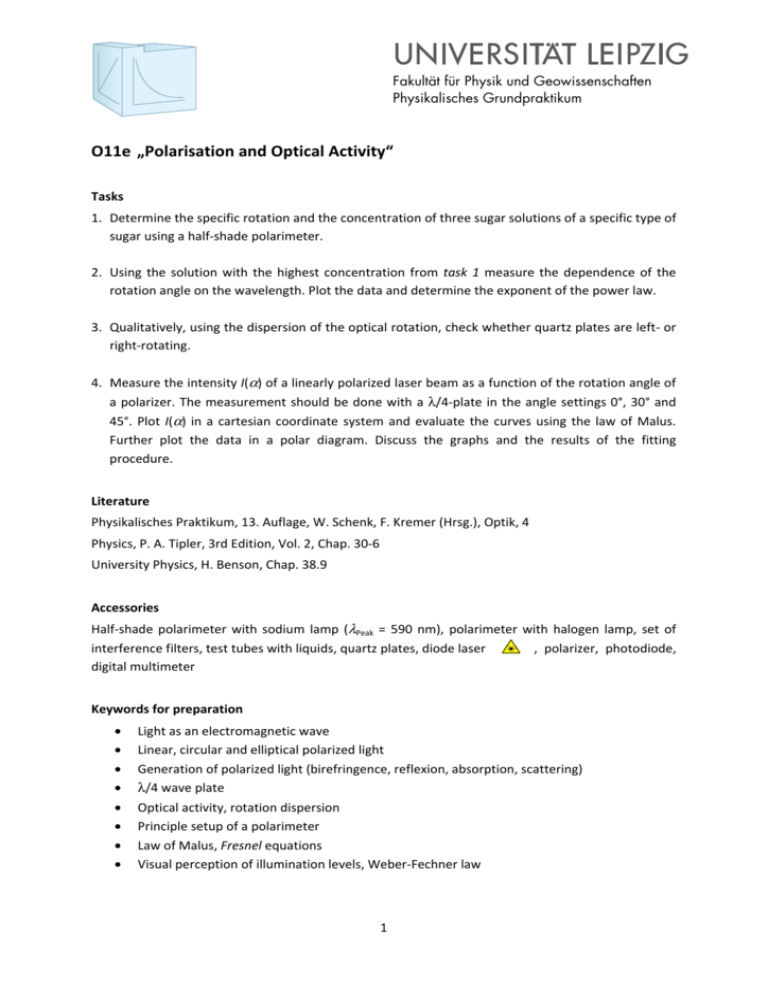
Fakultät für Physik und Geowissenschaften Physikalisches Grundpraktikum O11e „Polarisation and Optical Activity“ Tasks 1. Determine the specific rotation and the concentration of three sugar solutions of a specific type of sugar using a half-shade polarimeter. 2. Using the solution with the highest concentration from task 1 measure the dependence of the rotation angle on the wavelength. Plot the data and determine the exponent of the power law. 3. Qualitatively, using the dispersion of the optical rotation, check whether quartz plates are left- or right-rotating. 4. Measure the intensity I(α) of a linearly polarized laser beam as a function of the rotation angle of a polarizer. The measurement should be done with a λ/4-plate in the angle settings 0°, 30° and 45°. Plot I(α) in a cartesian coordinate system and evaluate the curves using the law of Malus. Further plot the data in a polar diagram. Discuss the graphs and the results of the fitting procedure. Literature Physikalisches Praktikum, 13. Auflage, W. Schenk, F. Kremer (Hrsg.), Optik, 4 Physics, P. A. Tipler, 3rd Edition, Vol. 2, Chap. 30-6 University Physics, H. Benson, Chap. 38.9 Accessories Half-shade polarimeter with sodium lamp (λPeak = 590 nm), polarimeter with halogen lamp, set of interference filters, test tubes with liquids, quartz plates, diode laser , polarizer, photodiode, digital multimeter Keywords for preparation • • • • Light as an electromagnetic wave Linear, circular and elliptical polarized light Generation of polarized light (birefringence, reflexion, absorption, scattering) λ/4 wave plate • • • • Optical activity, rotation dispersion Principle setup of a polarimeter Law of Malus, Fresnel equations Visual perception of illumination levels, Weber-Fechner law 1 Remarks In task 1 perform at least three measurements of the rotation angle for each test fluid. The concentration of one solution (standard solution) is known. From this the specific rotation can be determined for the given experimental conditions (ϑ, λ). Fig. 1. Half-shade polarimeter (L-light source, P-polarizer, H-prism, K-test tube of length l, A-analyzer). The mode of operation of a polarimeter is shown in Fig. 1. The light rays emitted by the monochromatic light source (L) are collimated by a lens before being linearly polarized by the polarizer (P). The plane of polarization of a part of the light beam is turned by a few degrees by the prism (H). The test tube (K) of length l = 200 mm contains the solution under study. By turning the analyzer (A) the rotation angle of the polarization plane can be determined. Fig. 2. Adjustment and reading of the angle (ϕ) at the half-shade polarimeter. The measurements should start with a check of the zero point of the polarimeter without test tube. To this end the different brightness of the inner and outer areas (Fig. 2a) of the half-shade polarimeter has to be compensated by turning the analyzer (Fig. 2b). Note that in a full 360° turn of the analyzer there are four settings with areas of equal brightness, two of these sensed dark and two of these sensed bright (compare with the law of Malus). Use the darker setting, since this allows the eye a more sensitive comparison of the brightness of the areas (Weber-Fechner law). The reading of the values is made with a degree scale divided from 0 to 180° with nonius. For the measurement of the rotation angle the test tube is brought into the light path and by turning the analyzer equal light intensities are adjusted in both areas (Fig. 2c). Note that only samples with a rotation angle -90°< ϕ < 90° can be measured with this polarimeter. In the investigation of the dispersion of the optical rotation in task 2 a relationship between the angle of rotation ϕ and the wavelength λ of the form ϕ∼λn is assumed. A plot of the ϕ - λ - diagram on a double logarithmic scale will lead to a straight line with a slope corresponding to the exponent n. The measurement is performed with a white-light polarimeter equipped with colour filters. Task 3 is carried out with the white-light polarimeter. Since the specific rotation depends on the wavelength (dispersion of the optical rotation), specific wavelength ranges of the white light are extinguished, depending on the setting of the analyzer (crossed). In case of left-rotating substances (mathematically positive direction of rotation) during leftward rotation of the analyzer the light is 2 extinguished in the colour series red – yellow – green – blue. The colour impression during this analyzer rotation corresponds to the series of complementary colours (subtractive mixture of colour) blue – green – yellow – red. In task 4 the intensity of linearly polarized monochromatic light is measured with a photo diode as a function of the angular setting between the direction of polarization and the direction of the analyzer. The intensity of the light passing a polarizer is proportional to the square of the cosine of the angle α between the direction of the polarization and the polarizer (law of Malus, see Fig. 3): cos2 (α − α0 ) = I (α ) / I 0 (I0: maximum intensity at α = α0). Fig. 3. Law of Malus With a λ/4-plate three measurement series should be performed with the angle between the optical axis of the λ/4-plate and the direction of polarization of the linearly polarized light set to 0°, 30° und 45°, respectively. A λ/4-plate is a thin layer made from an optically anisotropic material; in this material the speed of light (resp. the refractive index) depends on the direction of the polarization. Often materials with a unique optical axis are used that can be characterized by two refractive indices (for polarization directions parallel and perpendicular to the optical axis). Polarized light propagating through this uniaxial optical crystal can be decomposed into two electric field components, parallel and perpendicular to the optical axis. The velocities of light, v and v ⊥ , corresponding to these two electric field components are conventionally related to the extraordinary (e) and the ordinary (o) ray of light with principal refractive indices: ne = c0 / v , no = c0 / v⊥ . c0 denotes the speed of light in vacuum. The refractive index difference Δn = ne − no is a measure of the birefringence and determines its character, i.e. whether the crystal is optically negative or positive uniaxial. The following table shows a few examples. Material no ( ⊥ ) ne (⏐⏐) Δn calcite 1,6584 1,4864 -0,1720 turmaline 1,669 1,638 -0,031 quartz 1,5443 1,5534 +0,0091 (E. Hecht, Optik, 4. Auflage) Table 1. Refractive indices of selected uniaxial birefringent crystals at λ = 589 nm In case of optically positive uniaxial crystals, e.g. quartz (crystalline silicon dioxide, Δn > 0 ), one has v ⊥ > v , i.e. the ordinary ray propagates faster than the extraordinary ray. In case of calcite, being an optically negative uniaxial crystal, v is larger than v ⊥ (ne- no =-0,172). After passing through the crystal plate a phase shift of Δϕ = 2π λ d ( ne − no ) has developed between the two components. d denotes the geometrical thickness of the plate and λ the wavelength of the incoming light. Both rays interfere when leaving the crystal. In this way a new kind of polarization state of the light beam is generated (frequency and wavelength are unaffected). Consequently, a λ/4-plate is made for a 3 specific wavelength with the value of the phase shift Δϕ being determined by the thickness d of the plate. Depending on the amplitudes of the ordinary and extraordinary ray one obtains linearly polarized light (in case one ray has vanishing amplitude), elliptically polarized light or circularly polarized light (in case both rays have the same amplitude). The ratio of the amplitudes of both rays can be modified by the angle settings of the optical axis of the λ/4-plate with respect to the axis of polarization of the incoming linearly polarized light. As shown in Fig. 4 for the study of the polarization state of the incoming light a linear polarizer is used as analyzer. The transmitted intensity is measured by a photo diode. Fig. 4. Schematical setup for the law of Malus and the action of a λ/4-plate Instead of a λ/4-plate a (less expensive) λ/4-foil is used in the experiment. These wave plates are clear transparent foils with a thickness of 0.8 mm. There action corresponds to that of conventional gypsum or mica plates. Their use as λ/4-foil is appropriate in the wavelength range of 480-640 nm. For the intensity I = I(α) of the transmitted light behind the analyzer one obtains in dependence of the parameter θ (angle between the E-vector of the linearly polarized light and the optical axis of the λ/4-foil): I (α ) = E02 [cos 2 θ cos 2 (α − θ ) + sin 2 θ sin 2 (α − θ )] . 2 This equation may be derived by vector decomposition and the use of the law of Malus (a favoured question at the beginning of the laboratory session). Further rearranging leads to: I (α ) = I0 [1 + cos 2θ cos 2(θ − α )] 2 4




